Human Resource Management: Employee Motivation Strategies and Report
VerifiedAdded on 2020/04/21
|10
|2403
|222
Report
AI Summary
This report analyzes the critical role of employee motivation in organizational success, emphasizing its impact on achieving business objectives. It explores various human resource (HR) practices designed to enhance motivation, distinguishing between intrinsic and extrinsic motivators. The report examines specific strategies such as training, remuneration, and recognition, using examples from Google and GE to illustrate effective approaches. Google's emphasis on work-life balance, open culture, and unique benefits, along with GE's extensive training programs, are highlighted. The report further investigates the impact of employee engagement, performance management, and reward systems on motivation levels. It also details the importance of leadership and communication in fostering a motivated workforce. Ultimately, the report concludes that a combination of these HR practices is essential for creating a productive and engaged work environment, driving organizational performance.
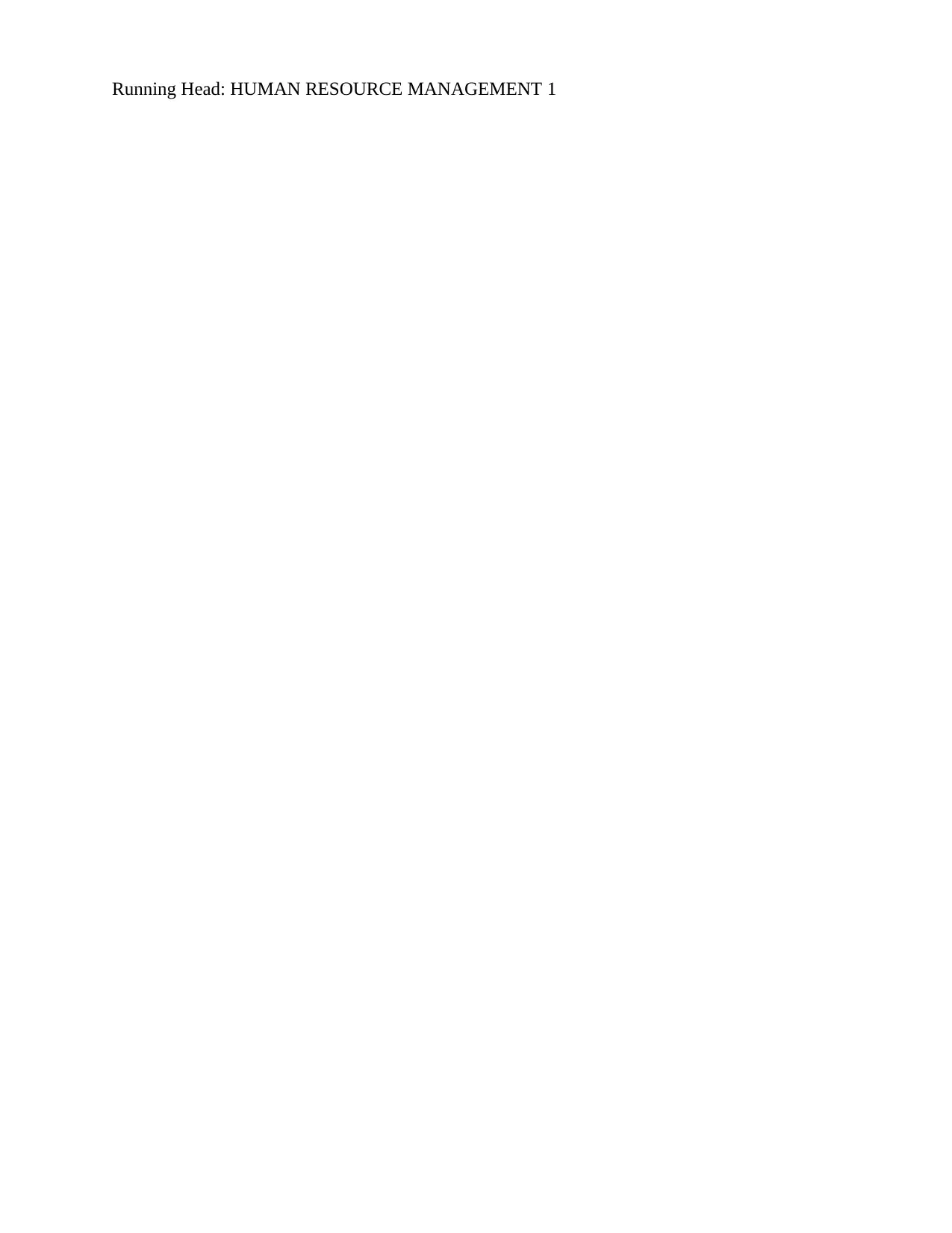
Running Head: HUMAN RESOURCE MANAGEMENT 1
Paraphrase This Document
Need a fresh take? Get an instant paraphrase of this document with our AI Paraphraser
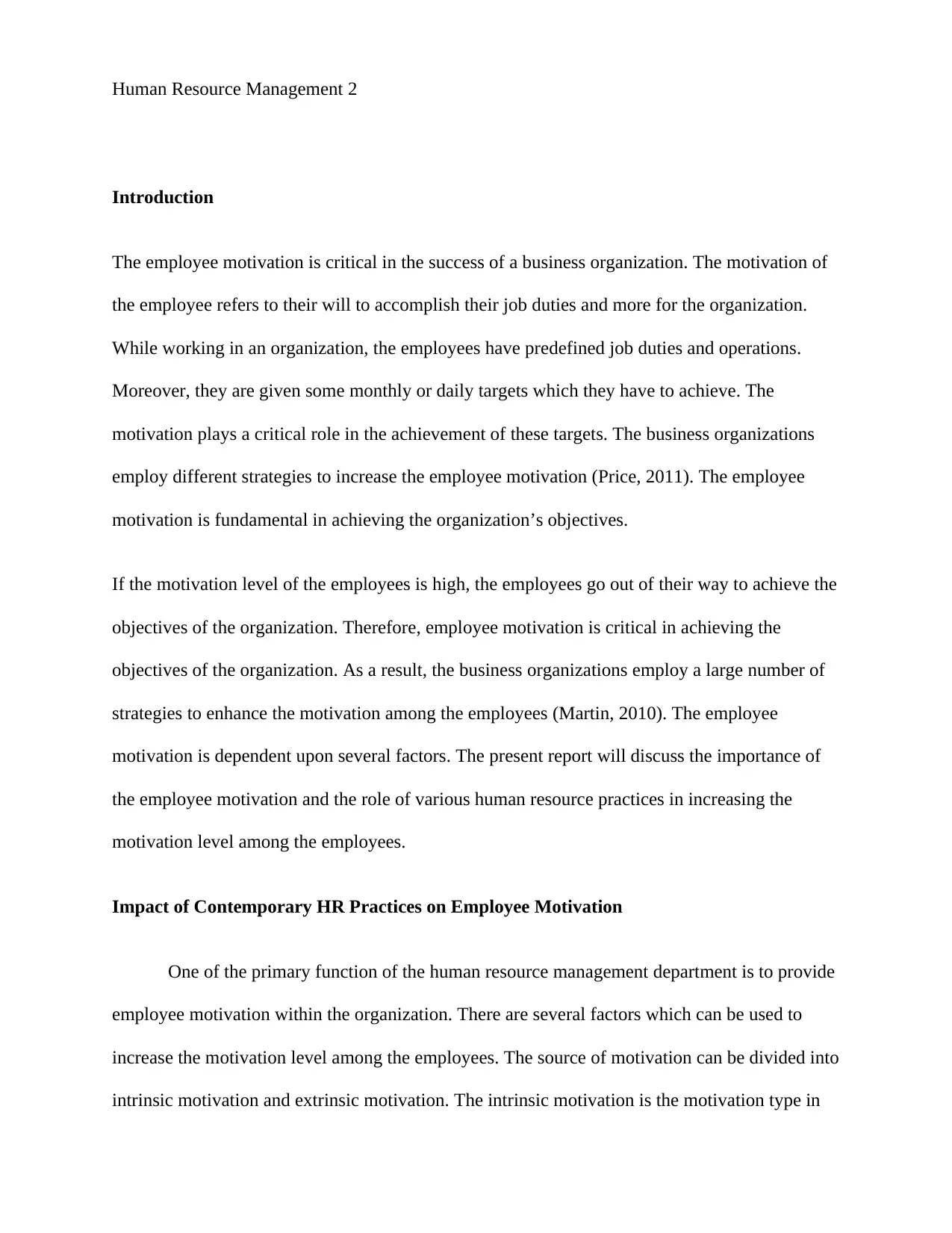
Human Resource Management 2
Introduction
The employee motivation is critical in the success of a business organization. The motivation of
the employee refers to their will to accomplish their job duties and more for the organization.
While working in an organization, the employees have predefined job duties and operations.
Moreover, they are given some monthly or daily targets which they have to achieve. The
motivation plays a critical role in the achievement of these targets. The business organizations
employ different strategies to increase the employee motivation (Price, 2011). The employee
motivation is fundamental in achieving the organization’s objectives.
If the motivation level of the employees is high, the employees go out of their way to achieve the
objectives of the organization. Therefore, employee motivation is critical in achieving the
objectives of the organization. As a result, the business organizations employ a large number of
strategies to enhance the motivation among the employees (Martin, 2010). The employee
motivation is dependent upon several factors. The present report will discuss the importance of
the employee motivation and the role of various human resource practices in increasing the
motivation level among the employees.
Impact of Contemporary HR Practices on Employee Motivation
One of the primary function of the human resource management department is to provide
employee motivation within the organization. There are several factors which can be used to
increase the motivation level among the employees. The source of motivation can be divided into
intrinsic motivation and extrinsic motivation. The intrinsic motivation is the motivation type in
Introduction
The employee motivation is critical in the success of a business organization. The motivation of
the employee refers to their will to accomplish their job duties and more for the organization.
While working in an organization, the employees have predefined job duties and operations.
Moreover, they are given some monthly or daily targets which they have to achieve. The
motivation plays a critical role in the achievement of these targets. The business organizations
employ different strategies to increase the employee motivation (Price, 2011). The employee
motivation is fundamental in achieving the organization’s objectives.
If the motivation level of the employees is high, the employees go out of their way to achieve the
objectives of the organization. Therefore, employee motivation is critical in achieving the
objectives of the organization. As a result, the business organizations employ a large number of
strategies to enhance the motivation among the employees (Martin, 2010). The employee
motivation is dependent upon several factors. The present report will discuss the importance of
the employee motivation and the role of various human resource practices in increasing the
motivation level among the employees.
Impact of Contemporary HR Practices on Employee Motivation
One of the primary function of the human resource management department is to provide
employee motivation within the organization. There are several factors which can be used to
increase the motivation level among the employees. The source of motivation can be divided into
intrinsic motivation and extrinsic motivation. The intrinsic motivation is the motivation type in
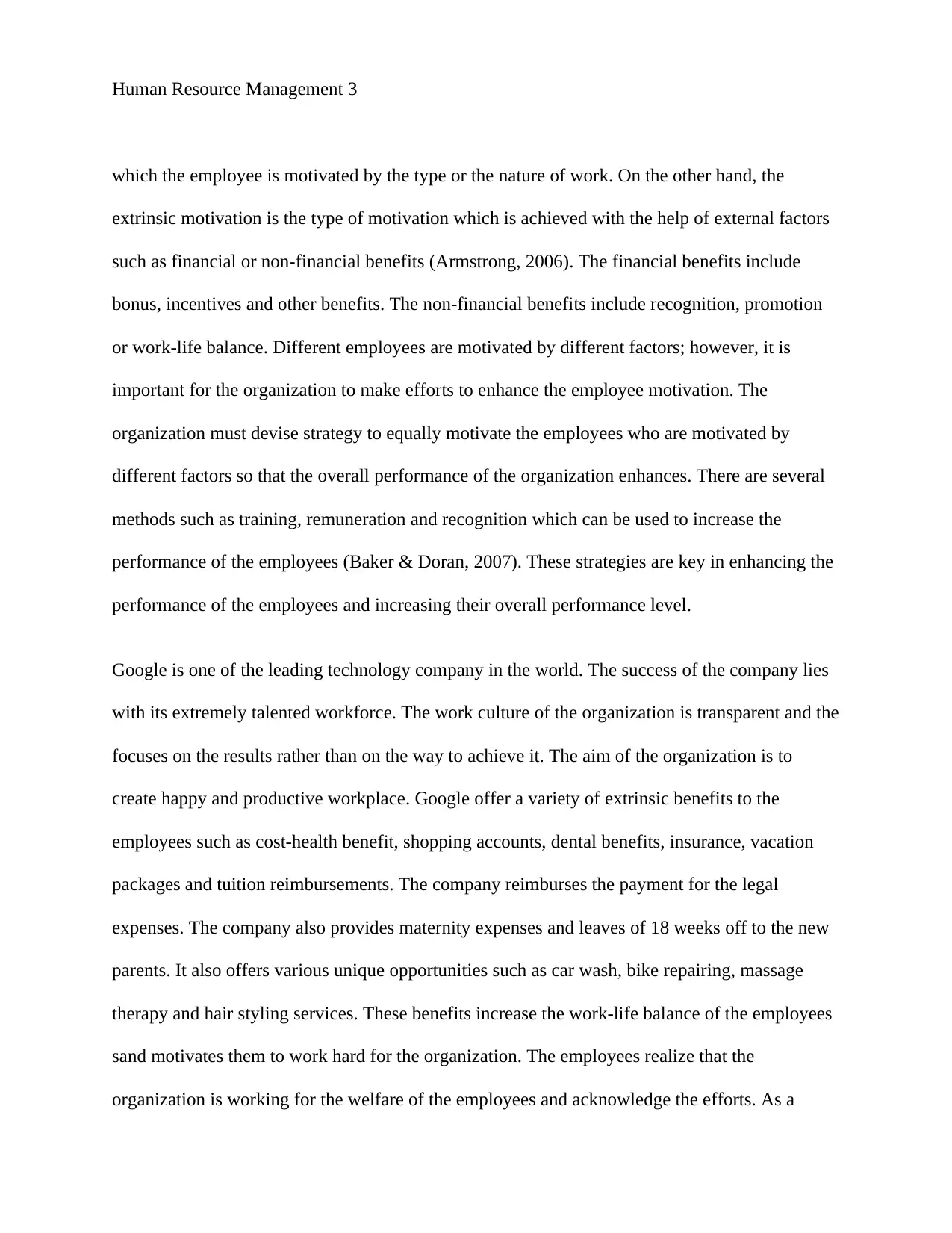
Human Resource Management 3
which the employee is motivated by the type or the nature of work. On the other hand, the
extrinsic motivation is the type of motivation which is achieved with the help of external factors
such as financial or non-financial benefits (Armstrong, 2006). The financial benefits include
bonus, incentives and other benefits. The non-financial benefits include recognition, promotion
or work-life balance. Different employees are motivated by different factors; however, it is
important for the organization to make efforts to enhance the employee motivation. The
organization must devise strategy to equally motivate the employees who are motivated by
different factors so that the overall performance of the organization enhances. There are several
methods such as training, remuneration and recognition which can be used to increase the
performance of the employees (Baker & Doran, 2007). These strategies are key in enhancing the
performance of the employees and increasing their overall performance level.
Google is one of the leading technology company in the world. The success of the company lies
with its extremely talented workforce. The work culture of the organization is transparent and the
focuses on the results rather than on the way to achieve it. The aim of the organization is to
create happy and productive workplace. Google offer a variety of extrinsic benefits to the
employees such as cost-health benefit, shopping accounts, dental benefits, insurance, vacation
packages and tuition reimbursements. The company reimburses the payment for the legal
expenses. The company also provides maternity expenses and leaves of 18 weeks off to the new
parents. It also offers various unique opportunities such as car wash, bike repairing, massage
therapy and hair styling services. These benefits increase the work-life balance of the employees
sand motivates them to work hard for the organization. The employees realize that the
organization is working for the welfare of the employees and acknowledge the efforts. As a
which the employee is motivated by the type or the nature of work. On the other hand, the
extrinsic motivation is the type of motivation which is achieved with the help of external factors
such as financial or non-financial benefits (Armstrong, 2006). The financial benefits include
bonus, incentives and other benefits. The non-financial benefits include recognition, promotion
or work-life balance. Different employees are motivated by different factors; however, it is
important for the organization to make efforts to enhance the employee motivation. The
organization must devise strategy to equally motivate the employees who are motivated by
different factors so that the overall performance of the organization enhances. There are several
methods such as training, remuneration and recognition which can be used to increase the
performance of the employees (Baker & Doran, 2007). These strategies are key in enhancing the
performance of the employees and increasing their overall performance level.
Google is one of the leading technology company in the world. The success of the company lies
with its extremely talented workforce. The work culture of the organization is transparent and the
focuses on the results rather than on the way to achieve it. The aim of the organization is to
create happy and productive workplace. Google offer a variety of extrinsic benefits to the
employees such as cost-health benefit, shopping accounts, dental benefits, insurance, vacation
packages and tuition reimbursements. The company reimburses the payment for the legal
expenses. The company also provides maternity expenses and leaves of 18 weeks off to the new
parents. It also offers various unique opportunities such as car wash, bike repairing, massage
therapy and hair styling services. These benefits increase the work-life balance of the employees
sand motivates them to work hard for the organization. The employees realize that the
organization is working for the welfare of the employees and acknowledge the efforts. As a
⊘ This is a preview!⊘
Do you want full access?
Subscribe today to unlock all pages.

Trusted by 1+ million students worldwide
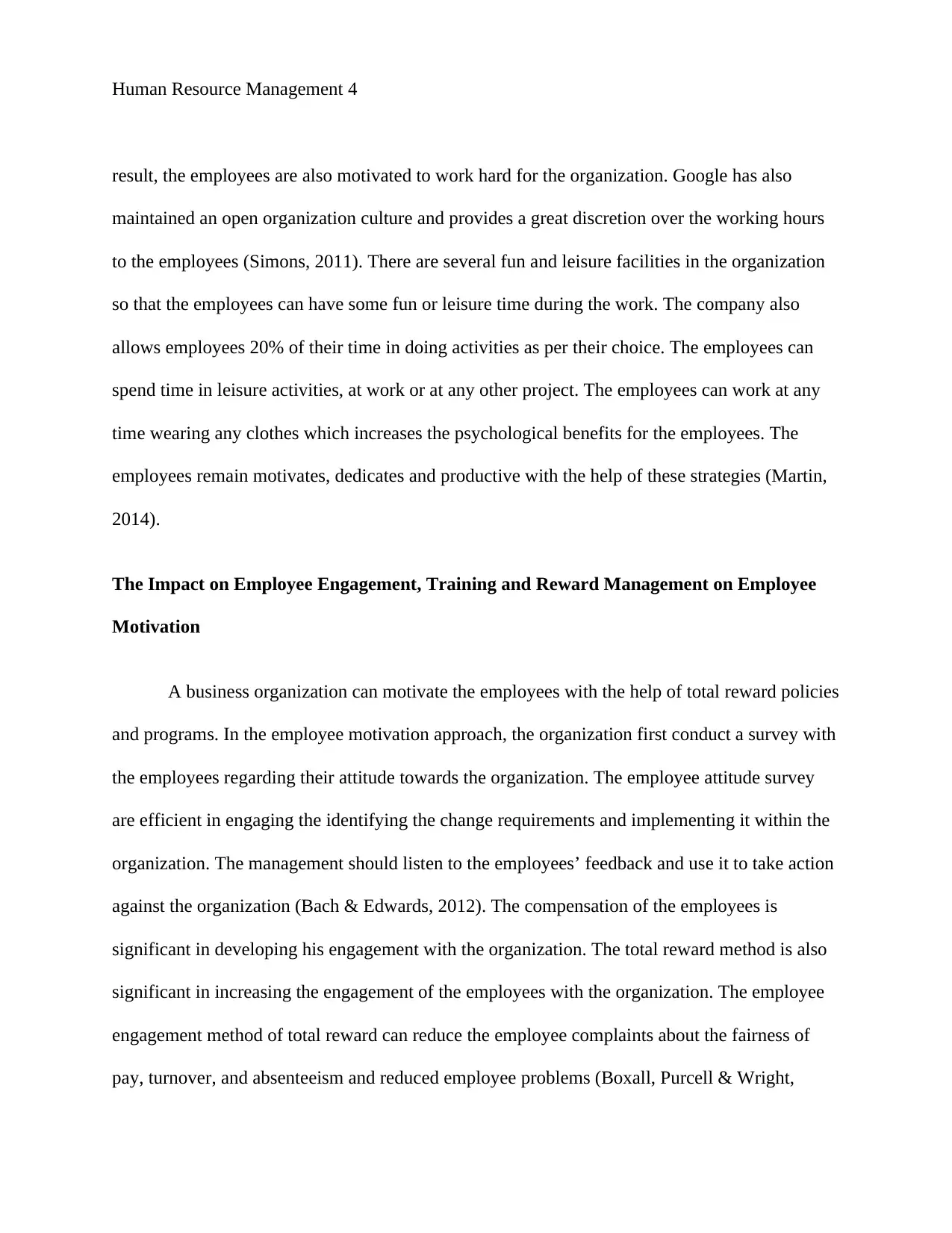
Human Resource Management 4
result, the employees are also motivated to work hard for the organization. Google has also
maintained an open organization culture and provides a great discretion over the working hours
to the employees (Simons, 2011). There are several fun and leisure facilities in the organization
so that the employees can have some fun or leisure time during the work. The company also
allows employees 20% of their time in doing activities as per their choice. The employees can
spend time in leisure activities, at work or at any other project. The employees can work at any
time wearing any clothes which increases the psychological benefits for the employees. The
employees remain motivates, dedicates and productive with the help of these strategies (Martin,
2014).
The Impact on Employee Engagement, Training and Reward Management on Employee
Motivation
A business organization can motivate the employees with the help of total reward policies
and programs. In the employee motivation approach, the organization first conduct a survey with
the employees regarding their attitude towards the organization. The employee attitude survey
are efficient in engaging the identifying the change requirements and implementing it within the
organization. The management should listen to the employees’ feedback and use it to take action
against the organization (Bach & Edwards, 2012). The compensation of the employees is
significant in developing his engagement with the organization. The total reward method is also
significant in increasing the engagement of the employees with the organization. The employee
engagement method of total reward can reduce the employee complaints about the fairness of
pay, turnover, and absenteeism and reduced employee problems (Boxall, Purcell & Wright,
result, the employees are also motivated to work hard for the organization. Google has also
maintained an open organization culture and provides a great discretion over the working hours
to the employees (Simons, 2011). There are several fun and leisure facilities in the organization
so that the employees can have some fun or leisure time during the work. The company also
allows employees 20% of their time in doing activities as per their choice. The employees can
spend time in leisure activities, at work or at any other project. The employees can work at any
time wearing any clothes which increases the psychological benefits for the employees. The
employees remain motivates, dedicates and productive with the help of these strategies (Martin,
2014).
The Impact on Employee Engagement, Training and Reward Management on Employee
Motivation
A business organization can motivate the employees with the help of total reward policies
and programs. In the employee motivation approach, the organization first conduct a survey with
the employees regarding their attitude towards the organization. The employee attitude survey
are efficient in engaging the identifying the change requirements and implementing it within the
organization. The management should listen to the employees’ feedback and use it to take action
against the organization (Bach & Edwards, 2012). The compensation of the employees is
significant in developing his engagement with the organization. The total reward method is also
significant in increasing the engagement of the employees with the organization. The employee
engagement method of total reward can reduce the employee complaints about the fairness of
pay, turnover, and absenteeism and reduced employee problems (Boxall, Purcell & Wright,
Paraphrase This Document
Need a fresh take? Get an instant paraphrase of this document with our AI Paraphraser
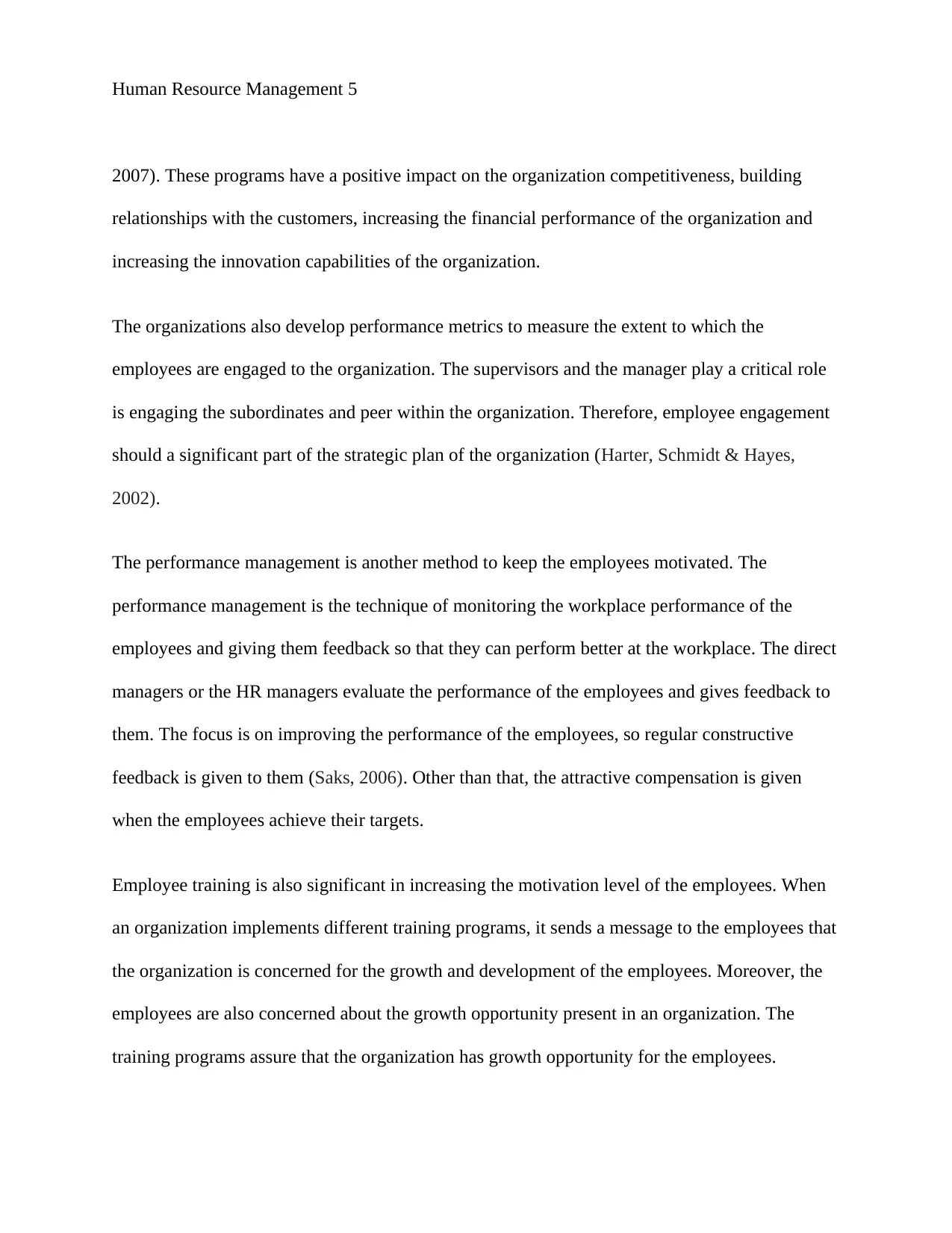
Human Resource Management 5
2007). These programs have a positive impact on the organization competitiveness, building
relationships with the customers, increasing the financial performance of the organization and
increasing the innovation capabilities of the organization.
The organizations also develop performance metrics to measure the extent to which the
employees are engaged to the organization. The supervisors and the manager play a critical role
is engaging the subordinates and peer within the organization. Therefore, employee engagement
should a significant part of the strategic plan of the organization (Harter, Schmidt & Hayes,
2002).
The performance management is another method to keep the employees motivated. The
performance management is the technique of monitoring the workplace performance of the
employees and giving them feedback so that they can perform better at the workplace. The direct
managers or the HR managers evaluate the performance of the employees and gives feedback to
them. The focus is on improving the performance of the employees, so regular constructive
feedback is given to them (Saks, 2006). Other than that, the attractive compensation is given
when the employees achieve their targets.
Employee training is also significant in increasing the motivation level of the employees. When
an organization implements different training programs, it sends a message to the employees that
the organization is concerned for the growth and development of the employees. Moreover, the
employees are also concerned about the growth opportunity present in an organization. The
training programs assure that the organization has growth opportunity for the employees.
2007). These programs have a positive impact on the organization competitiveness, building
relationships with the customers, increasing the financial performance of the organization and
increasing the innovation capabilities of the organization.
The organizations also develop performance metrics to measure the extent to which the
employees are engaged to the organization. The supervisors and the manager play a critical role
is engaging the subordinates and peer within the organization. Therefore, employee engagement
should a significant part of the strategic plan of the organization (Harter, Schmidt & Hayes,
2002).
The performance management is another method to keep the employees motivated. The
performance management is the technique of monitoring the workplace performance of the
employees and giving them feedback so that they can perform better at the workplace. The direct
managers or the HR managers evaluate the performance of the employees and gives feedback to
them. The focus is on improving the performance of the employees, so regular constructive
feedback is given to them (Saks, 2006). Other than that, the attractive compensation is given
when the employees achieve their targets.
Employee training is also significant in increasing the motivation level of the employees. When
an organization implements different training programs, it sends a message to the employees that
the organization is concerned for the growth and development of the employees. Moreover, the
employees are also concerned about the growth opportunity present in an organization. The
training programs assure that the organization has growth opportunity for the employees.
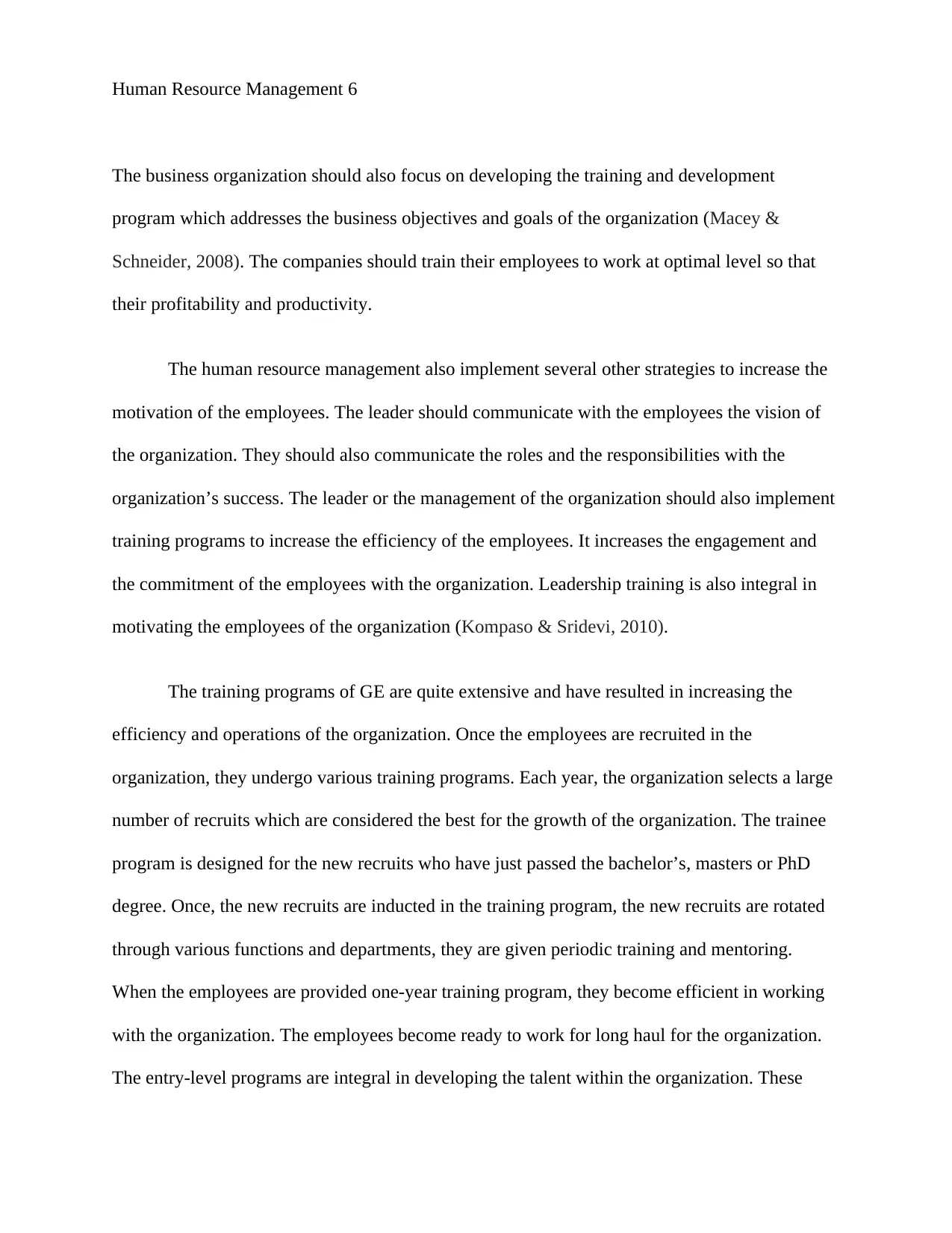
Human Resource Management 6
The business organization should also focus on developing the training and development
program which addresses the business objectives and goals of the organization (Macey &
Schneider, 2008). The companies should train their employees to work at optimal level so that
their profitability and productivity.
The human resource management also implement several other strategies to increase the
motivation of the employees. The leader should communicate with the employees the vision of
the organization. They should also communicate the roles and the responsibilities with the
organization’s success. The leader or the management of the organization should also implement
training programs to increase the efficiency of the employees. It increases the engagement and
the commitment of the employees with the organization. Leadership training is also integral in
motivating the employees of the organization (Kompaso & Sridevi, 2010).
The training programs of GE are quite extensive and have resulted in increasing the
efficiency and operations of the organization. Once the employees are recruited in the
organization, they undergo various training programs. Each year, the organization selects a large
number of recruits which are considered the best for the growth of the organization. The trainee
program is designed for the new recruits who have just passed the bachelor’s, masters or PhD
degree. Once, the new recruits are inducted in the training program, the new recruits are rotated
through various functions and departments, they are given periodic training and mentoring.
When the employees are provided one-year training program, they become efficient in working
with the organization. The employees become ready to work for long haul for the organization.
The entry-level programs are integral in developing the talent within the organization. These
The business organization should also focus on developing the training and development
program which addresses the business objectives and goals of the organization (Macey &
Schneider, 2008). The companies should train their employees to work at optimal level so that
their profitability and productivity.
The human resource management also implement several other strategies to increase the
motivation of the employees. The leader should communicate with the employees the vision of
the organization. They should also communicate the roles and the responsibilities with the
organization’s success. The leader or the management of the organization should also implement
training programs to increase the efficiency of the employees. It increases the engagement and
the commitment of the employees with the organization. Leadership training is also integral in
motivating the employees of the organization (Kompaso & Sridevi, 2010).
The training programs of GE are quite extensive and have resulted in increasing the
efficiency and operations of the organization. Once the employees are recruited in the
organization, they undergo various training programs. Each year, the organization selects a large
number of recruits which are considered the best for the growth of the organization. The trainee
program is designed for the new recruits who have just passed the bachelor’s, masters or PhD
degree. Once, the new recruits are inducted in the training program, the new recruits are rotated
through various functions and departments, they are given periodic training and mentoring.
When the employees are provided one-year training program, they become efficient in working
with the organization. The employees become ready to work for long haul for the organization.
The entry-level programs are integral in developing the talent within the organization. These
⊘ This is a preview!⊘
Do you want full access?
Subscribe today to unlock all pages.

Trusted by 1+ million students worldwide
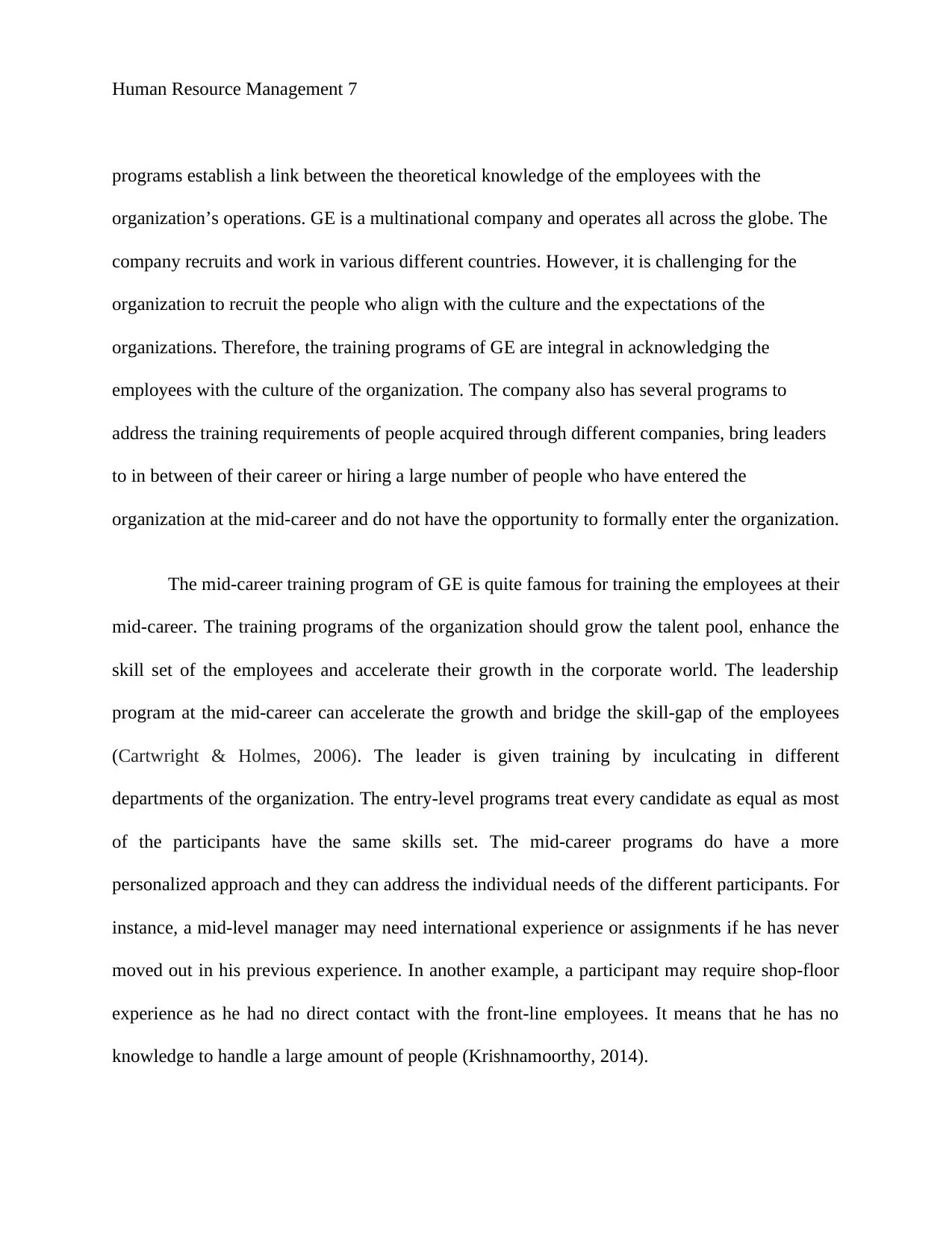
Human Resource Management 7
programs establish a link between the theoretical knowledge of the employees with the
organization’s operations. GE is a multinational company and operates all across the globe. The
company recruits and work in various different countries. However, it is challenging for the
organization to recruit the people who align with the culture and the expectations of the
organizations. Therefore, the training programs of GE are integral in acknowledging the
employees with the culture of the organization. The company also has several programs to
address the training requirements of people acquired through different companies, bring leaders
to in between of their career or hiring a large number of people who have entered the
organization at the mid-career and do not have the opportunity to formally enter the organization.
The mid-career training program of GE is quite famous for training the employees at their
mid-career. The training programs of the organization should grow the talent pool, enhance the
skill set of the employees and accelerate their growth in the corporate world. The leadership
program at the mid-career can accelerate the growth and bridge the skill-gap of the employees
(Cartwright & Holmes, 2006). The leader is given training by inculcating in different
departments of the organization. The entry-level programs treat every candidate as equal as most
of the participants have the same skills set. The mid-career programs do have a more
personalized approach and they can address the individual needs of the different participants. For
instance, a mid-level manager may need international experience or assignments if he has never
moved out in his previous experience. In another example, a participant may require shop-floor
experience as he had no direct contact with the front-line employees. It means that he has no
knowledge to handle a large amount of people (Krishnamoorthy, 2014).
programs establish a link between the theoretical knowledge of the employees with the
organization’s operations. GE is a multinational company and operates all across the globe. The
company recruits and work in various different countries. However, it is challenging for the
organization to recruit the people who align with the culture and the expectations of the
organizations. Therefore, the training programs of GE are integral in acknowledging the
employees with the culture of the organization. The company also has several programs to
address the training requirements of people acquired through different companies, bring leaders
to in between of their career or hiring a large number of people who have entered the
organization at the mid-career and do not have the opportunity to formally enter the organization.
The mid-career training program of GE is quite famous for training the employees at their
mid-career. The training programs of the organization should grow the talent pool, enhance the
skill set of the employees and accelerate their growth in the corporate world. The leadership
program at the mid-career can accelerate the growth and bridge the skill-gap of the employees
(Cartwright & Holmes, 2006). The leader is given training by inculcating in different
departments of the organization. The entry-level programs treat every candidate as equal as most
of the participants have the same skills set. The mid-career programs do have a more
personalized approach and they can address the individual needs of the different participants. For
instance, a mid-level manager may need international experience or assignments if he has never
moved out in his previous experience. In another example, a participant may require shop-floor
experience as he had no direct contact with the front-line employees. It means that he has no
knowledge to handle a large amount of people (Krishnamoorthy, 2014).
Paraphrase This Document
Need a fresh take? Get an instant paraphrase of this document with our AI Paraphraser
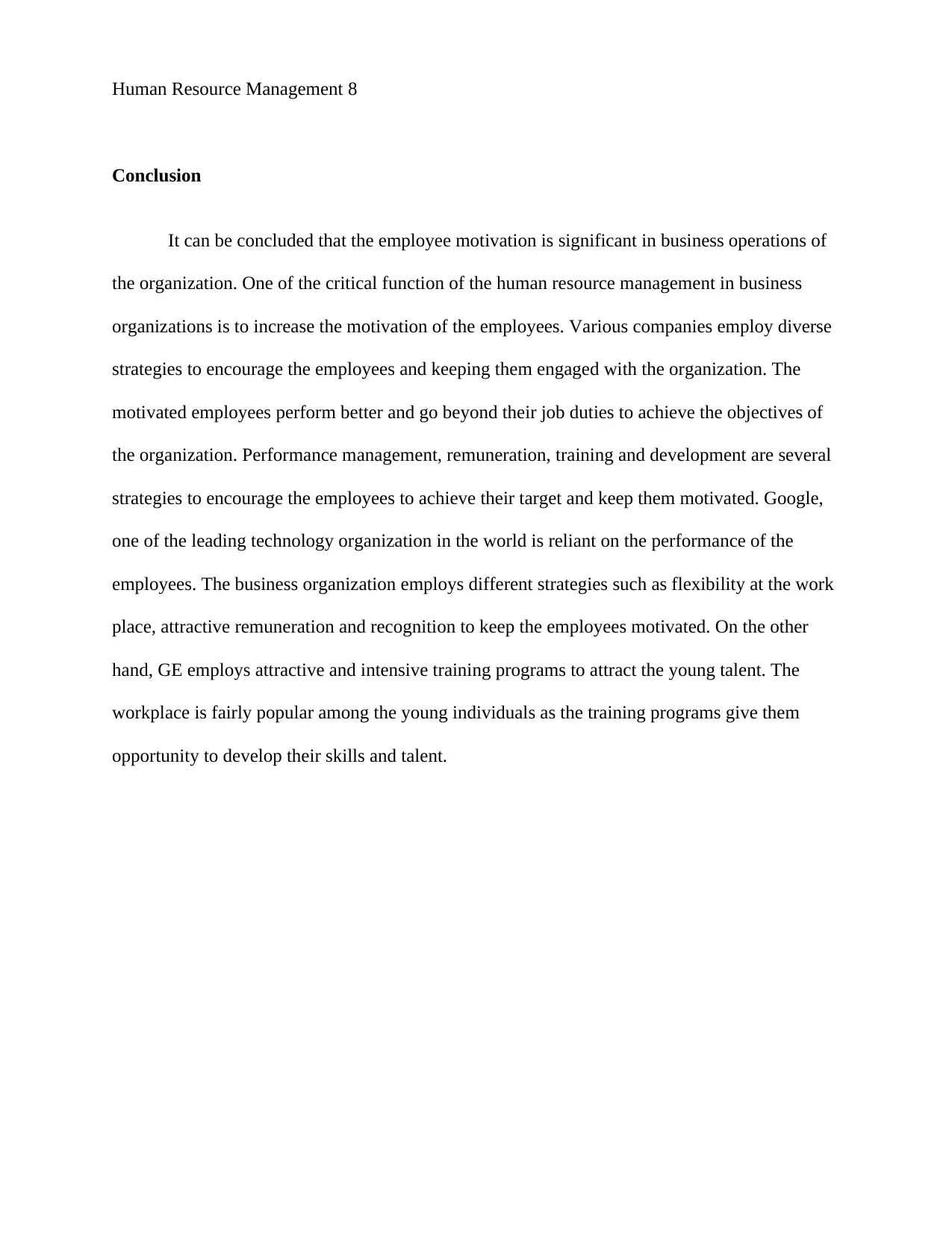
Human Resource Management 8
Conclusion
It can be concluded that the employee motivation is significant in business operations of
the organization. One of the critical function of the human resource management in business
organizations is to increase the motivation of the employees. Various companies employ diverse
strategies to encourage the employees and keeping them engaged with the organization. The
motivated employees perform better and go beyond their job duties to achieve the objectives of
the organization. Performance management, remuneration, training and development are several
strategies to encourage the employees to achieve their target and keep them motivated. Google,
one of the leading technology organization in the world is reliant on the performance of the
employees. The business organization employs different strategies such as flexibility at the work
place, attractive remuneration and recognition to keep the employees motivated. On the other
hand, GE employs attractive and intensive training programs to attract the young talent. The
workplace is fairly popular among the young individuals as the training programs give them
opportunity to develop their skills and talent.
Conclusion
It can be concluded that the employee motivation is significant in business operations of
the organization. One of the critical function of the human resource management in business
organizations is to increase the motivation of the employees. Various companies employ diverse
strategies to encourage the employees and keeping them engaged with the organization. The
motivated employees perform better and go beyond their job duties to achieve the objectives of
the organization. Performance management, remuneration, training and development are several
strategies to encourage the employees to achieve their target and keep them motivated. Google,
one of the leading technology organization in the world is reliant on the performance of the
employees. The business organization employs different strategies such as flexibility at the work
place, attractive remuneration and recognition to keep the employees motivated. On the other
hand, GE employs attractive and intensive training programs to attract the young talent. The
workplace is fairly popular among the young individuals as the training programs give them
opportunity to develop their skills and talent.
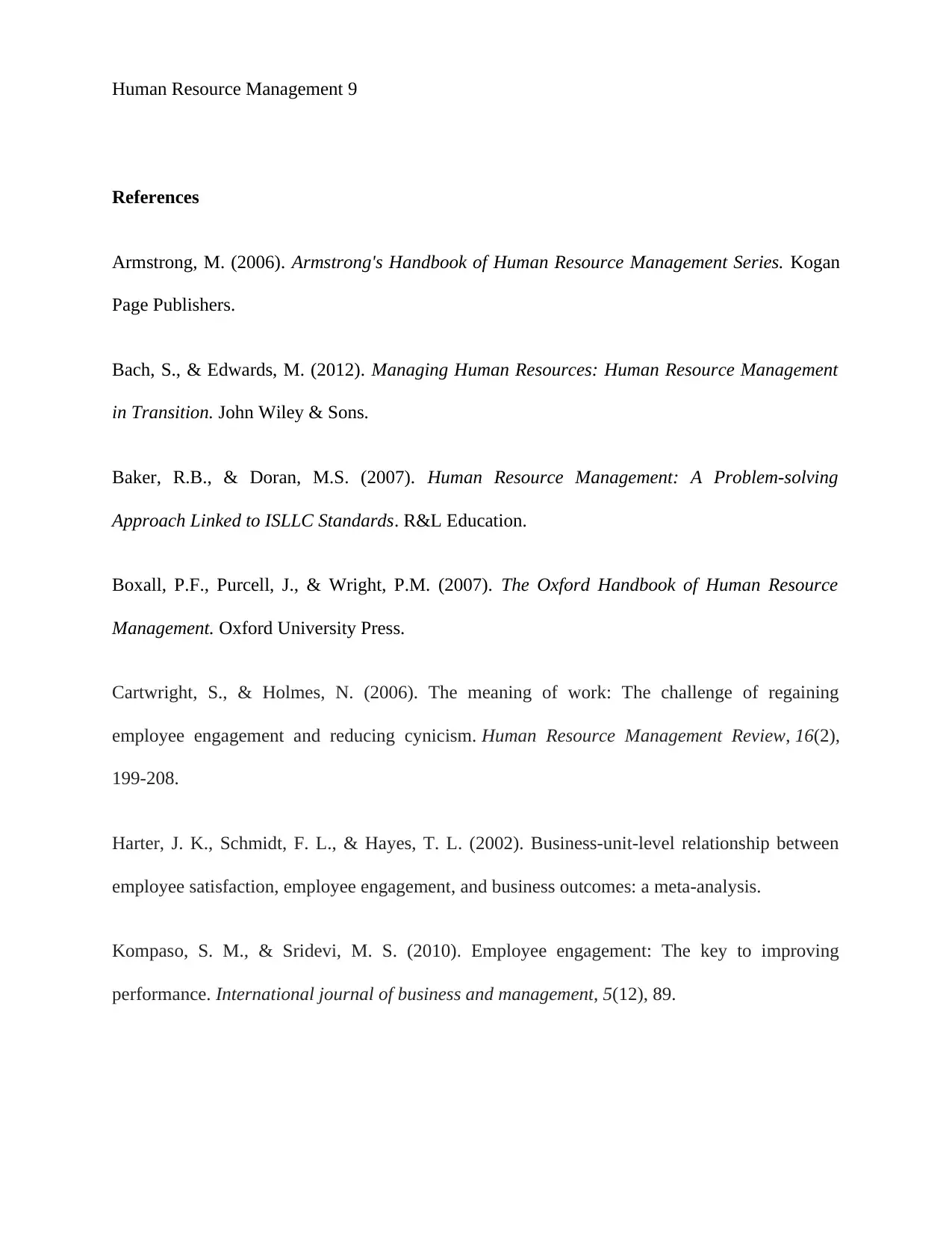
Human Resource Management 9
References
Armstrong, M. (2006). Armstrong's Handbook of Human Resource Management Series. Kogan
Page Publishers.
Bach, S., & Edwards, M. (2012). Managing Human Resources: Human Resource Management
in Transition. John Wiley & Sons.
Baker, R.B., & Doran, M.S. (2007). Human Resource Management: A Problem-solving
Approach Linked to ISLLC Standards. R&L Education.
Boxall, P.F., Purcell, J., & Wright, P.M. (2007). The Oxford Handbook of Human Resource
Management. Oxford University Press.
Cartwright, S., & Holmes, N. (2006). The meaning of work: The challenge of regaining
employee engagement and reducing cynicism. Human Resource Management Review, 16(2),
199-208.
Harter, J. K., Schmidt, F. L., & Hayes, T. L. (2002). Business-unit-level relationship between
employee satisfaction, employee engagement, and business outcomes: a meta-analysis.
Kompaso, S. M., & Sridevi, M. S. (2010). Employee engagement: The key to improving
performance. International journal of business and management, 5(12), 89.
References
Armstrong, M. (2006). Armstrong's Handbook of Human Resource Management Series. Kogan
Page Publishers.
Bach, S., & Edwards, M. (2012). Managing Human Resources: Human Resource Management
in Transition. John Wiley & Sons.
Baker, R.B., & Doran, M.S. (2007). Human Resource Management: A Problem-solving
Approach Linked to ISLLC Standards. R&L Education.
Boxall, P.F., Purcell, J., & Wright, P.M. (2007). The Oxford Handbook of Human Resource
Management. Oxford University Press.
Cartwright, S., & Holmes, N. (2006). The meaning of work: The challenge of regaining
employee engagement and reducing cynicism. Human Resource Management Review, 16(2),
199-208.
Harter, J. K., Schmidt, F. L., & Hayes, T. L. (2002). Business-unit-level relationship between
employee satisfaction, employee engagement, and business outcomes: a meta-analysis.
Kompaso, S. M., & Sridevi, M. S. (2010). Employee engagement: The key to improving
performance. International journal of business and management, 5(12), 89.
⊘ This is a preview!⊘
Do you want full access?
Subscribe today to unlock all pages.

Trusted by 1+ million students worldwide
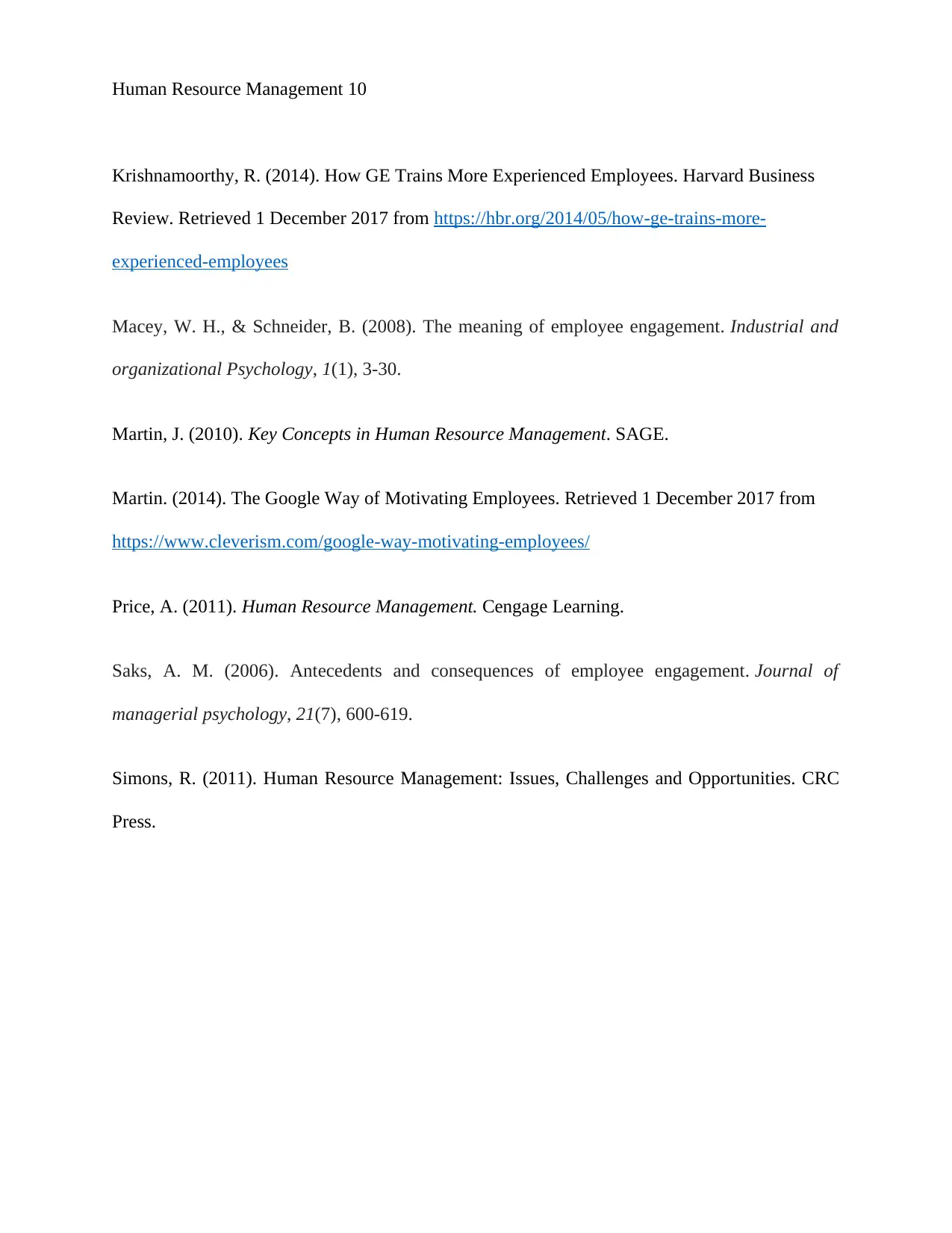
Human Resource Management 10
Krishnamoorthy, R. (2014). How GE Trains More Experienced Employees. Harvard Business
Review. Retrieved 1 December 2017 from https://hbr.org/2014/05/how-ge-trains-more-
experienced-employees
Macey, W. H., & Schneider, B. (2008). The meaning of employee engagement. Industrial and
organizational Psychology, 1(1), 3-30.
Martin, J. (2010). Key Concepts in Human Resource Management. SAGE.
Martin. (2014). The Google Way of Motivating Employees. Retrieved 1 December 2017 from
https://www.cleverism.com/google-way-motivating-employees/
Price, A. (2011). Human Resource Management. Cengage Learning.
Saks, A. M. (2006). Antecedents and consequences of employee engagement. Journal of
managerial psychology, 21(7), 600-619.
Simons, R. (2011). Human Resource Management: Issues, Challenges and Opportunities. CRC
Press.
Krishnamoorthy, R. (2014). How GE Trains More Experienced Employees. Harvard Business
Review. Retrieved 1 December 2017 from https://hbr.org/2014/05/how-ge-trains-more-
experienced-employees
Macey, W. H., & Schneider, B. (2008). The meaning of employee engagement. Industrial and
organizational Psychology, 1(1), 3-30.
Martin, J. (2010). Key Concepts in Human Resource Management. SAGE.
Martin. (2014). The Google Way of Motivating Employees. Retrieved 1 December 2017 from
https://www.cleverism.com/google-way-motivating-employees/
Price, A. (2011). Human Resource Management. Cengage Learning.
Saks, A. M. (2006). Antecedents and consequences of employee engagement. Journal of
managerial psychology, 21(7), 600-619.
Simons, R. (2011). Human Resource Management: Issues, Challenges and Opportunities. CRC
Press.
1 out of 10
Related Documents
Your All-in-One AI-Powered Toolkit for Academic Success.
+13062052269
info@desklib.com
Available 24*7 on WhatsApp / Email
![[object Object]](/_next/static/media/star-bottom.7253800d.svg)
Unlock your academic potential
Copyright © 2020–2025 A2Z Services. All Rights Reserved. Developed and managed by ZUCOL.





